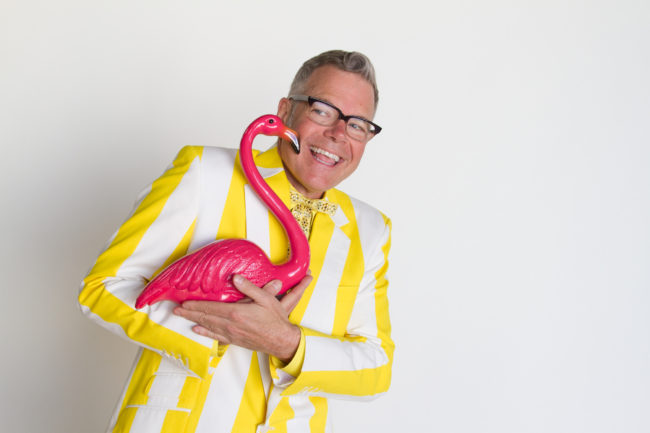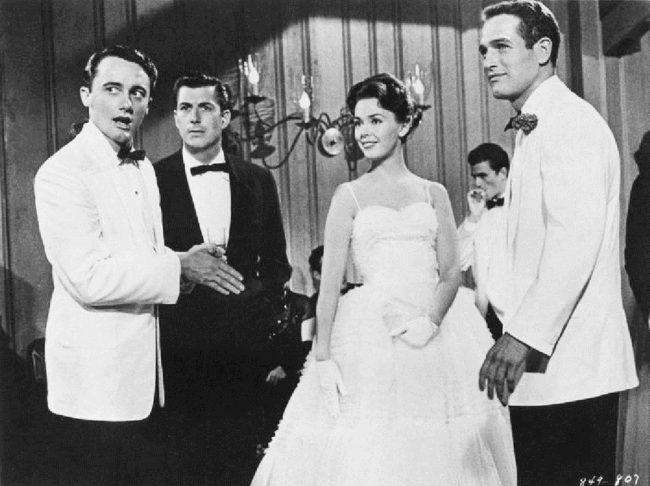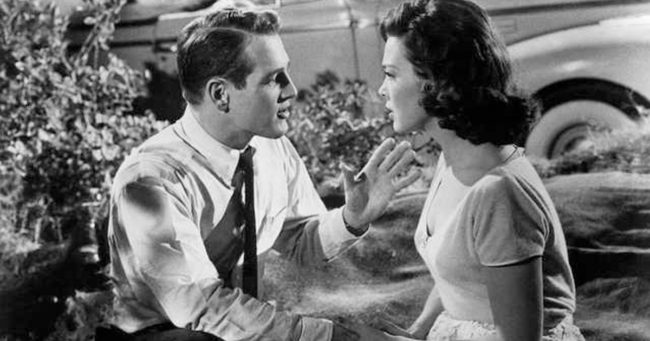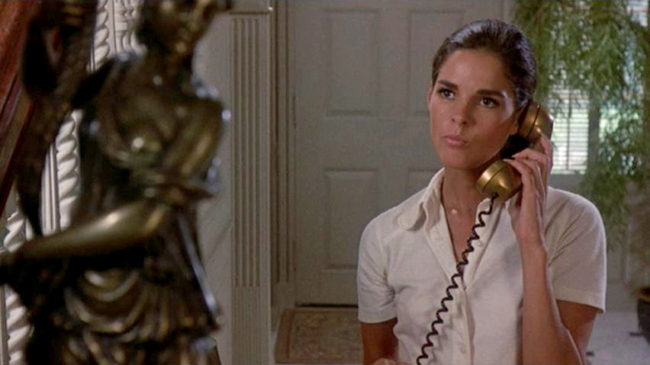THIS CHANGES EVERYTHING Geena Davis and Jackie Cruz will participate in a Q&A moderated by Madeline DiNonno following the 7:00 pm show on Friday, 8/9.
Pop Culture Humorist Charles Phoenix Presents the Lucille Ball-Desi Arnaz Comedy Classic THE LONG, LONG TRAILER.
Laemmle Theatres and the Anniversary Classics Series, partnered with retro pop culture humorist Charles Phoenix, present a 65th anniversary screening of the Lucille Ball-Desi Arnaz comedy classic THE LONG, LONG TRAILER, directed by Vincente Minnelli.
The Special Event evening features Phoenix with his retro slide show tribute to the film, its iconic stars, and the colorful history of travel trailers.
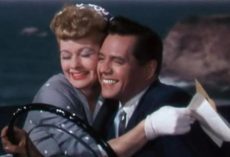 THE LONG, LONG TRAILER (1954) is a comedy showcasing the talents of Lucille Ball and Desi Arnaz at the height of their popularity. MGM studio executives questioned the box office viability of a movie with the married couple since they could be seen every week in the highest-rated show on television, I Love Lucy.
THE LONG, LONG TRAILER (1954) is a comedy showcasing the talents of Lucille Ball and Desi Arnaz at the height of their popularity. MGM studio executives questioned the box office viability of a movie with the married couple since they could be seen every week in the highest-rated show on television, I Love Lucy.
Veteran producer Pandro S. Berman enlisted director Minnelli (Meet Me in St. Louis, Father of the Bride, An American in Paris, Gigi) and screenwriters Albert Hackett and Frances Goodrich (The Thin Man, It’s a Wonderful Life, Father of the Bride, Seven Brides for Seven Brothers) to concoct a movie from the best-selling memoir-novel of Clinton Twiss about his trailer travels with his wife.
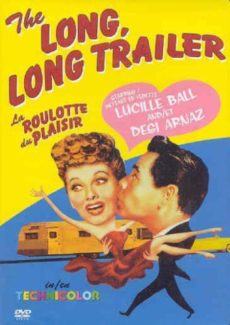 The filmmakers lightly satirized the mid-century American ethos, marriage, and conspicuous consumption, offering American audiences what they couldn’t get at home on their black-and-white TV sets – Lucy and Desi in glorious Technicolor in essentially a travelogue of California.
The filmmakers lightly satirized the mid-century American ethos, marriage, and conspicuous consumption, offering American audiences what they couldn’t get at home on their black-and-white TV sets – Lucy and Desi in glorious Technicolor in essentially a travelogue of California.
The film about newlyweds Nicky (Arnaz) and Tracy (Ball) on their honeymoon trip trailer-adventures utilizes reliable character actors Marjorie Main, Keenan Wynn, and Moroni Olsen along the way, and saturated color cinematography by multiple Oscar winner Robert Surtees. The film was a box office smash in its day, vindicating the commercial instincts of the filmmakers. Leonard Maltin calls it “an enduringly popular slapstick comedy…almost an I Love Lucy episode on wheels.”
Charles Phoenix, the “Ambassador of Americana,” is known for his live comedy retro slide show performances, JOYRIDE videos, field trip tours, “test kitchen” concoctions and colorful coffee table books (Addicted to Americana, Southern Californialand, Americana the Beautiful), all celebrating America’s classic and kitschy pop culture past and present.
This Special Event of the Anniversary Classics Series is presented on Saturday, August 17 at the vintage jewel box theater, the Ahrya Fine Arts, a perfect showcase for retro humorist Phoenix. Come join the celebration of this mid-twentieth century comedy, its iconic stars, and the history of travel trailers in Kodachrome. Festive attire is encouraged!
Sixtieth Anniversary Screening of THE YOUNG PHILADELPHIANS with Actress Barbara Rush In Person
Laemmle Theatres and the Anniversary Classics Series present a rediscovery of a juicy melodrama from 1959: THE YOUNG PHILADELPHIANS, which boasted a vibrant cast headed by Paul Newman and our special guest, Barbara Rush. As Leonard Maltin wrote in his review, “Newman and Rush have memorable roles as poor lawyer who schemes to the top and society girl he hopes to win.”
Newman was rising to major stardom at the time he made this film. He was coming off acclaimed performances in Somebody Up There Likes Me and The Long Hot Summer and had just earned his first Oscar nomination for Cat on a Hot Tin Roof. As the Motion Picture Herald observed in its review of The Young Philadelphians, “Newman demonstrates once again that he stands in the forefront of the crop of young players who have come to the screen in recent years.”
The film was adapted by James Gunn from the best-selling novel by Richard Powell that many compared to the enormously successful Peyton Place in exposing the sexual shenanigans and professional rivalries among a tight-knit community surrounding Philadelphia’s Main Line. Newman plays an ambitious young man with a shady past who is determined to rise to the top ranks of society. He becomes a lawyer who learns how to inveigle a number of wealthy clients but rediscovers his principles when he defends an old friend on a murder charge.
Robert Vaughn, in a breakthrough performance of his own, plays the murder suspect, and he earned an Oscar nomination for his compelling performance in the film. But the entire cast was strong. As Film Daily observed, “The story is given life and fire through an imposing array of performances.” Rush plays Newman’s love interest, though he also has a dalliance with a married socialite played by Alexis Smith. The supporting cast includes established actors Billie Burke, Otto Kruger, and John Williams, along with newer faces Brian Keith, Diane Brewster, and Adam West (later to play TV’s Batman) in his film debut.
Vincent Sherman (All Through the Night, Old Acquaintance, Mr. Skeffington, The Damned Don’t Cry) directed, and The Hollywood Reporter declared, “The direction by Vincent Sherman is the best in his long and able career.” The film received two additional Oscar nominations, for black-and-white cinematography by veteran Harry Stradling and black-and-white costume design by Howard Shoup.
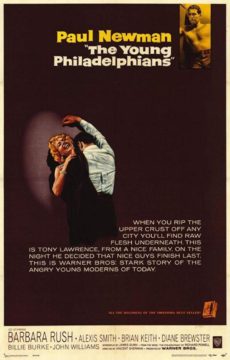 Barbara Rush also co-starred with Newman in Hombre, and her many other film credits include Magnificent Obsession with Rock Hudson and Jane Wyman, Bigger Than Life with James Mason, Strangers When We Meet with Kirk Douglas, Come Blow Your Horn and Robin and the 7 Hoods with Frank Sinatra, along with two early sci-fi classics, When Worlds Collide and It Came From Outer Space. Rush had a co-starring role on the Peyton Place TV series of the 60s, and she later starred in the series Flamingo Road and 7th Heaven. Just in the last year, she was discovered by a whole new audience portraying a wealthy widow in a series of witty commercials for Wilshire Coin.
Barbara Rush also co-starred with Newman in Hombre, and her many other film credits include Magnificent Obsession with Rock Hudson and Jane Wyman, Bigger Than Life with James Mason, Strangers When We Meet with Kirk Douglas, Come Blow Your Horn and Robin and the 7 Hoods with Frank Sinatra, along with two early sci-fi classics, When Worlds Collide and It Came From Outer Space. Rush had a co-starring role on the Peyton Place TV series of the 60s, and she later starred in the series Flamingo Road and 7th Heaven. Just in the last year, she was discovered by a whole new audience portraying a wealthy widow in a series of witty commercials for Wilshire Coin.
Our 60th anniversary presentation of THE YOUNG PHILADELPHIANS plus Q&A with Barbara Rush screens on Wednesday, August 7th at 7 PM at the Royal in West LA. Click here for tickets.
Format: DVD
AT WAR Q&A’s with Filmmaker Opening Weekend at the Royal.
AT WAR director Stéphane Brizé will participate in Q&As following the 7:00 pm show on Friday, 7/26 and Saturday, 7/27.
SKIN Star Jamie Bell in Person Opening Weekend at the Royal.
SKIN Jamie Bell will participate in a Q&A following the 7:10 pm show on Saturday, 7/27.
Masters of El Prado: A Collection of Documentaries about the Most Renowned Artists from Museo del Prado.
Take a trip to Spain this summer and see Bosch, Sorolla and Murillo on the big screen as part of our Culture Vulture series at the Claremont, Playhouse, Royal, and Town Center.
MURILLO: THE LAST JOURNEY is more than a documentary about one of the greatest geniuses of fine art. It provides a view at the history of the Spanish empire at its height from the perspective of one of Murillo’s most iconic paintings: The Young Peddler. The painting travels from Seville to Paris as world-renowned specialists flesh out the exquisite aesthetics of the painter’s most sublime masterpieces. We’ll screen this August 5 and 6.
BOSCH: THE GARDEN OF DREAMS, screening August 12 and 13, was produced by LópezLiFilms and the Prado Museum, which this year commemorates the fifth centenary of the painter’s death with a major exhibition entitled “Bosch. The Centenary Exhibition.”
Under the direction of Jose Luis Lopez Linares, the film focuses on the most important work of the painter and one of the most iconic in the world: ‘The Garden of Earthly Delights.’ The feature presents a conversation among artists, writers, philosophers, musicians and scientists, regarding the personal, historical and artistic significance of the picture, bringing back a conversation that was started 500 years ago in the court of the Dukes of Nassau (Brussels), when it is believed that the painting was commissioned to Bosch.
We have very little information about the artist’s identity and biography, something that helps feed the enigma of the hidden meaning in his works. As Falkenburg, narrator of the documentary and debate moderator with all participants says, “At the end of the novel, the writer reveals the mystery. In this case, the author does not want you to solve the mystery. He wants you to stay in it.”
BOSCH: THE GARDEN OF DREAMS is the only film about the author’s most important masterpiece: “The garden of earthly delights” and the only one with full access to the mysteries hidden in it.
SOROLLA: THE NATURAL EMOTION is the result of the documentary record of the first great anthological exhibition that the Prado Museum dedicated to the great master of the 19th century and the most important held inside and outside of Spain: Joaquín Sorolla (1863-1923); it’s a culmination of the itinerancy in Spain of the fourteen panels of the Vision of Spain, commissioned by the Hispanic Society of America, which the Bancaja Foundation brought to Spain in 2007. This spectacular set constitutes the most magnificent decorative project of Sorolla’s fecund career, in addition of the true epilogue and synthesis of all its production.
The representation of the light, the beauty of his pastel brushstrokes, the love of his native land as well as the relationship with his family and many other issues, are explored by experts in the field, creating a production where the figure of of Sorolla is exalted and revealed.
Producer López Linares comments that “it was a great discovery that there were so many photos of Sorolla, suddenly we had an incredible photographic archive, with magnificent photos of him painting, when he was older, on the beach, family photos … It was all very well documented. It’s a pleasant surprise for the documentary to find you with this photographic richness, it’s wonderful.”
GOODBYE, COLUMBUS 50th Anniversary Screening with Stars Richard Benjamin and Ali MacGraw and Director Larry Peerce In-Person
Laemmle Theatres and the Anniversary Classics Series present a screening of one of the landmark comedies of the 1960s and perhaps the best screen rendition of the work of Philip Roth: the adaptation of his National Book Award-winning novella, GOODBYE, COLUMBUS.
The movie launched the careers of its two stars, Richard Benjamin and Ali MacGraw, who will both join us for this reunion screening, along with the film’s director, Larry Peerce.
Roth was a master chronicler of the Jewish-American experience, and this film version dealt forthrightly and sardonically with the author’s favorite milieu. In focusing on a doomed love affair between a young working-class man and a spoiled Jewish-American princess, the film caught many of the tensions in affluent American society during the postwar years. Its sexual candor also reflected changing mores of the late 60s.
Arnold Schulman was nominated for an Academy Award for his screenplay, and he also won the Writers Guild award for best adapted screenplay of the year. Stanley Jaffe (Kramer vs. Kramer, Fatal Attraction) produced the picture. The Association provided the musical score.
Benjamin plays Neil Klugman, who meets Brenda Patimkin when his cousin invites him to swim at her ritzy country club. Neil is immediately attracted to Brenda, and she finds him intriguing, especially as a way of goading her snobbish, nouveau riche parents, expertly played by Jack Klugman and Nan Martin. When Brenda invites Neil as a house guest, they begin an affair right in the family mansion.
The film includes a number of sharply defined characters, especially Brenda’s affable but dim jock brother, played by Michael Meyers, whom Peerce discovered at a wedding. It turned out to be the only screen performance by Meyers, who went on to have a successful career as a doctor and later wrote a book about his journey from Hollywood to hospitals.
The film climaxes with a scene of Meyers’ garish and gargantuan wedding reception, which was somewhat controversial because of the gusto with which it satirized Jewish conspicuous consumption. In this wedding sequence, director Peerce’s father—the noted tenor, Jan Peerce—makes a sly cameo appearance.
The film scored at the box office and received enthusiastic reviews. The New York Times’ Vincent Canby declared, “Goodbye, Columbus is so rich with understanding… that it is a thing of real and unusual pleasure.” Variety called the film “a joy in striking a boisterous mood” and added that Benjamin and MacGraw “offer fresh portrayals seasoned with rich humor.”
Indeed the film catapulted both actors to the top ranks in Hollywood. MacGraw earned an Oscar nomination the following year for the smash hit Love Story, and she starred in Sam Peckinpah’s The Getaway with her husband-to-be, Steve McQueen. She also starred in Sidney Lumet’s satire, Just Tell Me What You Want, and in the enormously successful TV miniseries, The Winds of War. Benjamin played in such films as Diary of a Mad Housewife, Westworld, The Last of Sheila, The Sunshine Boys, as well as the adaptation of Roth’s most controversial novel, Portnoy’s Complaint. Later Benjamin became an acclaimed director of such films as My Favorite Year, Racing with the Moon, and Mermaids.
 Peerce made his feature directorial debut with the groundbreaking 1964 film about an interracial romance, One Potato Two Potato, and followed up with a gritty urban thriller, The Incident. His other films include The Sporting Club, A Separate Peace, The Bell Jar, and the uplifting female sports movie, The Other Side of the Mountain.
Peerce made his feature directorial debut with the groundbreaking 1964 film about an interracial romance, One Potato Two Potato, and followed up with a gritty urban thriller, The Incident. His other films include The Sporting Club, A Separate Peace, The Bell Jar, and the uplifting female sports movie, The Other Side of the Mountain.
Our 50th anniversary presentation of GOODBYE, COLUMBUS (1969) followed by a Q&A with stars Richard Benjamin and Ali MacGraw and director Larry Peerce screens Friday, August 2nd at 7:30 PM at the Ahrya Fine Arts in Beverly Hills. Click here for tickets.
Format: DVD.
CHAIN OF DEATH Q&A with Cast & Crew Opening Night at the Music Hall.
CHAIN OF DEATH director David Martin Porras and producer Elisa Lleras will participate in a Q&A joined by cast members Adrienne Barbeau, Josh Patrick Amedori, Madeline Zima and Jamie Clayton and moderated by John Alan Simon following the 9:55 pm show on Friday, 7/19.
- « Previous Page
- 1
- …
- 77
- 78
- 79
- 80
- 81
- …
- 269
- Next Page »

